6 of the Best Youth Football Defenses

As former NFL coaches, FirstDown PlayBook knows the importance of playing sound defense, no matter what league or level you coach in. The interesting thing is that there are really only six or so basic defenses that you would play at any level. This is especially true for a youth football defense.
When coaching youth football defense, there are several reasons you want to teach your kids sound defensive football principles. Number one is that when youth football defense is played with sound schemes and technique, it goes a long way towards making it safer for the young players. This means that you should incorporate sound youth football drills too. Coaching youth football requires thinking about player safety first and foremost.
A Good Youth Football Coach Will Always Look At Player Safety First
The second reason sound defensive schemes should be taught is that it gives a youth football player a chance to develop. Not all of your players are going to continue playing in high school. However, what you don’t want is kids who have come through your system to arrive at the prep level with no football foundation.
June Is Youth Football Month At FirstDown PlayBook!
The third reason is that your defense will be more successful. Yes, you are going to see a lot of crazy things out there on the internet. A lot of it has no business being taught to young football players. Teaching tried and proven sound football defense is going to allow your players to have a positive experience. That may not always parlay into winning, but when you teach youth football defense, you will ultimately help your team be better.
Now that we have those three very important things noted, let’s get started with the coaching part. So, what is my first step and when do I get started? There is never a bad time of year to prepare your youth football defense for the season. However, we would advise that the earlier, the better. Why? Well, for starters, you can work out all of your adjustments in the off-season. You don’t need your players to work on this.
Before You Draw Up Your Defense, First Take A Look At Your Roster
So, where should you start? The same place that any good football coach starts…with your players. If you have some idea about what your roster is going to look like, that can help you a lot. Just breaking your team down into three categories will help you. Identify your players as either a lineman, a linebacker, or a defensive back.
Keep in mind that this should not be done exclusively based on size. There are plenty of good undersized defensive linemen and bigger kids who play well in a 2 point stance. However, this is a starting point to determine the best youth football defense to be your base. If you have a lot of bigger players on your defense, you may want to consider a 6-2 front. If you have more linebacker types, then 4-4 front may be your best bet. Don’t forget to use the FirstDown PlayBook™ Youth Football Play Library & Play Drawing Tool to quickly and easily find the best defensive scheme for your team, and then edit it to your liking!
Take A Look At Your Schedule Too
Your schedule and your opponents can be part of your decision about your defense. If you know you are going to play against a lot of spread offenses, you may need to have a flexible defense that can adjust to this. Your opponents’ players will have a lot to do with this. Just because your opponent lines up in a spread formation, does not mean that they can run a spread offense.
We are NFL coaches and we know a lot about football. What we do not know is your roster. So, we are going to give you what a lot of coaches want, options. Your job when coaching football defense for kids is to look at your options, then decide what is best for your team. You should look hard at your players, your schedule, your opponents, and most importantly, the experience of the person in the mirror. These variables will help you choose the best youth football defense. Let’s get started!
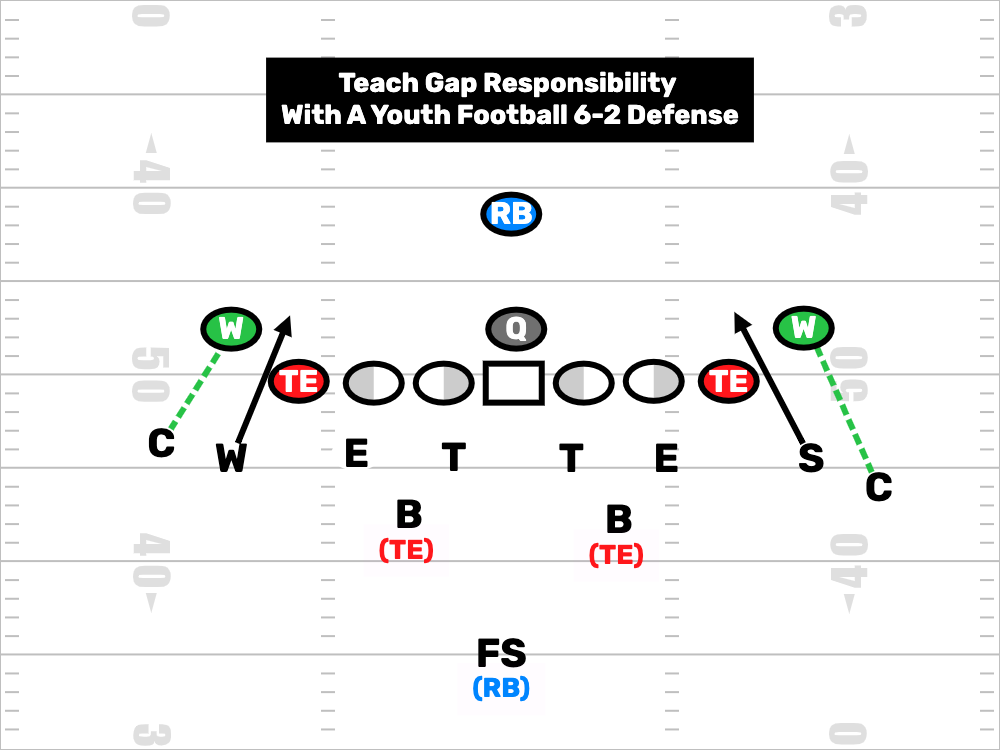
1. 6-2 Youth Football Defense
If you ask us, you should have a very good reason if you run any kids’ football defense other than the 6-2. The reason is that this is the best run-stopping defense you can run at the youth football level. It is not the only run-stopping defense, but it is the simplest and the best. Every player knows their gap assignment before the ball is ever snapped. That is the best way to stop the run. That is why NFL teams get into a 6-2 defense on the goal line.
You are going to hear youth football coaches swear that if you run a 6-2, they will throw for 300 yards on your defense. You will hear how the 6-2 is an outdated defense. They say this because they don’t see a 6-2 defense at the high school, college or NFL level. That is because the quarterbacks at those levels can hurt a 6-2 defense with their arm. 90% of the quarterbacks you will play at the youth level will not hurt you throwing the ball. This is true no matter what defense you choose to run
The 6-2 youth football defense is exactly as you might imagine. You are committing eight players to the line of scrimmage to stop the run. There are adjustments that allow you to cover all of the eligibles, but once again, stopping the run is the main focus here. Click on the drawing to learn more.
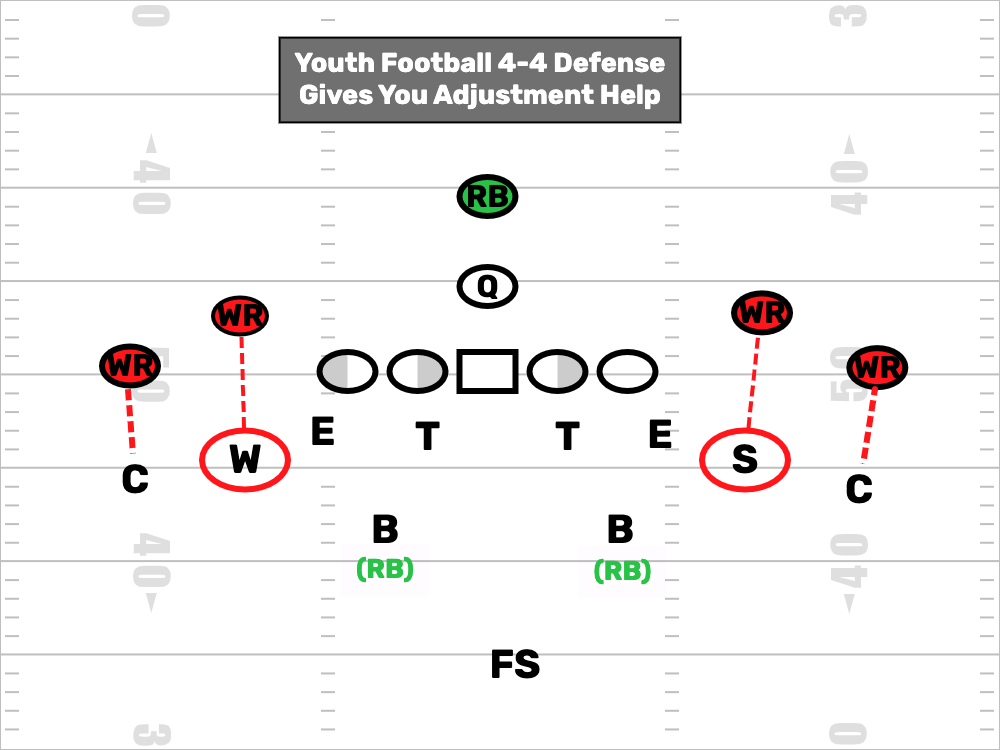
2. 4-4 Youth Football Defense
What if you have more linebacker types on your roster than you do defensive linemen? This is where a 4-4 might be a sound football defense for kids to consider. A 4-4 youth football defense still commits eight defenders close to the line of scrimmage.
This allows you to stop the run like the 6-2 defense. Your four linebackers will now have to understand run flow to and away from them. If you have three or four players with a nose for the ball, the 4-4 defense might be for you. Just make sure you incorporate some youth football drills to help your linebackers with this scheme.
These days, more and more youth football coaches are spreading the field with their formations. Right or wrong, it is happening. There are several ways to defend this. We would first recommend that you still defend the run first. Don’t let a 10-year-old quarterback scare you out of your run defense. You could, however, adjust with a 4-4 defense. A 4-4 defense will allow you to cover the slot receivers and still be a factor defending the run.
Now, if you do run into a special quarterback who plays like a 13-year-old even though he is 11, you have an answer. The other advantage of a sound 4-4 youth football defense is that it allows you to adjust to formation shifts, tight end trades, and receiver motions. So, take a look around your neighborhood. If you have some very talented young quarterbacks to defend, the 4-4 might be a good thought.
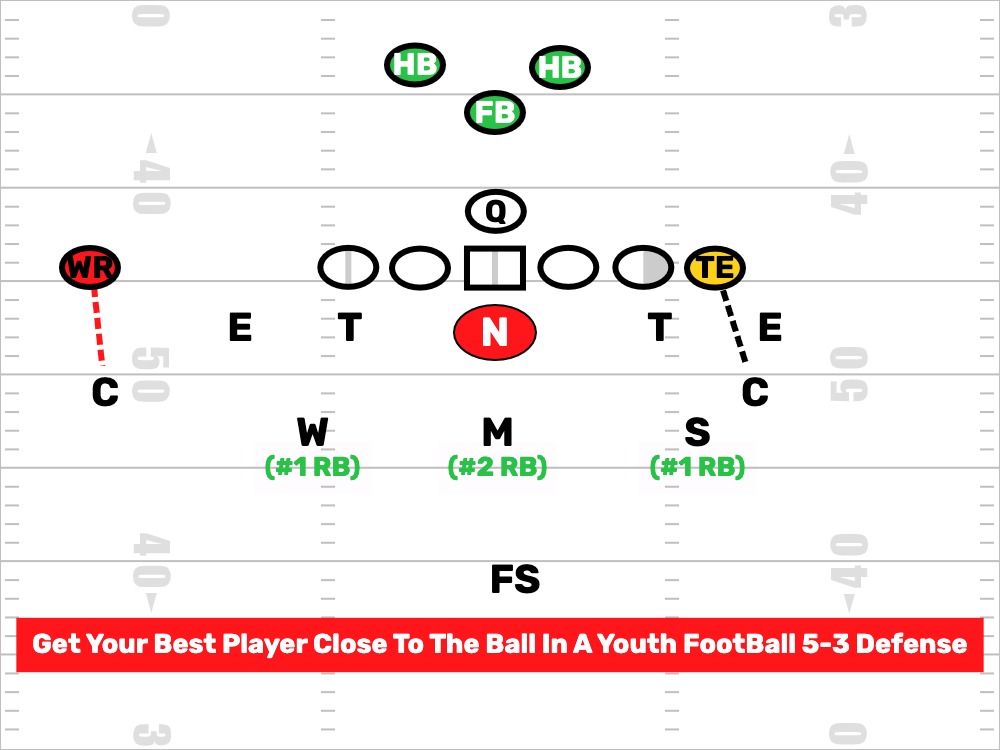
3. 5-3 Youth Football Defense
There is no rule that says that you have to run an even front with your kids’ football defense. You still commit eight defenders to the line of scrimmage when you run a 5-3 defense. The difference is that now you play with a nose guard, two tackles, and two ends. If you only have five or six defensive linemen types then this is a good thought. You never know when one of your linemen is going to miss a game for one reason or another.
The more relevant reason for running a sound 5-3 youth football defense is that you have a talented young nose guard on your team. Think about it this way: When you line your best player up over the center, you have placed them as close to the ball as possible. This has advantages even if your nose guard does not make the play. Often times, the nose guard disrupts the blocking scheme. This allows the other players to swarm the ball.
A 5-3 football defense for kids is set up to incorporate defensive line slants and angles too. When you line up in a 5-3 defense, you are perfectly balanced on the snap. You are playing your nose in a zero technique, your tackles in a five technique, and your ends are outside keeping contain. On the snap of the ball, your defense can slant one way or another making them hard to block.
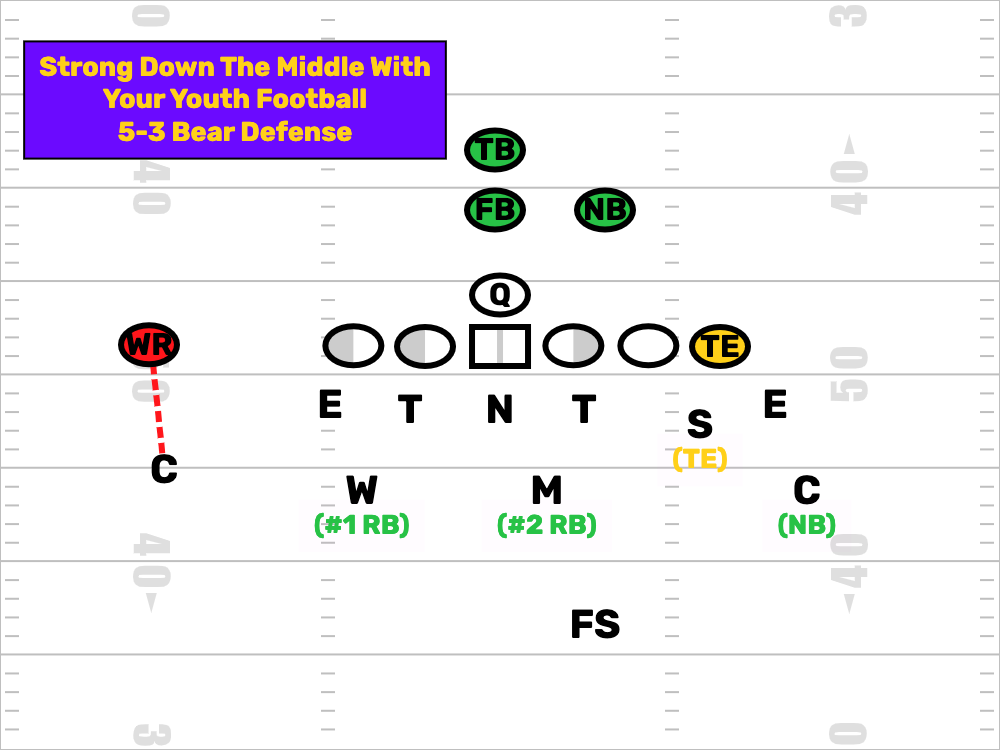
4. 5-3 Bear Youth Football Defense
A close kin to the 5-3 youth football defense is the 5-3 Bear. Yes, it is a version of the 46 Bear defense made famous by FirstDown PlayBook’s Mike Singletary. The difference is that, once again, this defense is modified to fit a youth football team. There is a heavy emphasis on stopping the youth football run game first.
If you are looking for a way to be strong up the middle with your kids’ football defense, then FirstDown PlayBook’s 5-3 Bear defense might be for you. Your personnel needs to play a part in this decision though. If you have a dominant defensive lineman to play the nose position, this is a good start. In this way, it is once again similar to a base 5-3 defense.
If you want to understand why the 5-3 youth football defense is so sound up the middle, just look at your gaps. Not only do you have one of your better, if not your best, players playing right over the ball. You also have both B gaps defended. The coaching point for your tackles here is simple. Stay in the B gap. Keep your outside arm free unless you get a down block from the tackle. If that happens, you create a pile. This defense is almost sure to make the ball bounce outside. Just make sure you have players on the perimeter to make the play when it does!
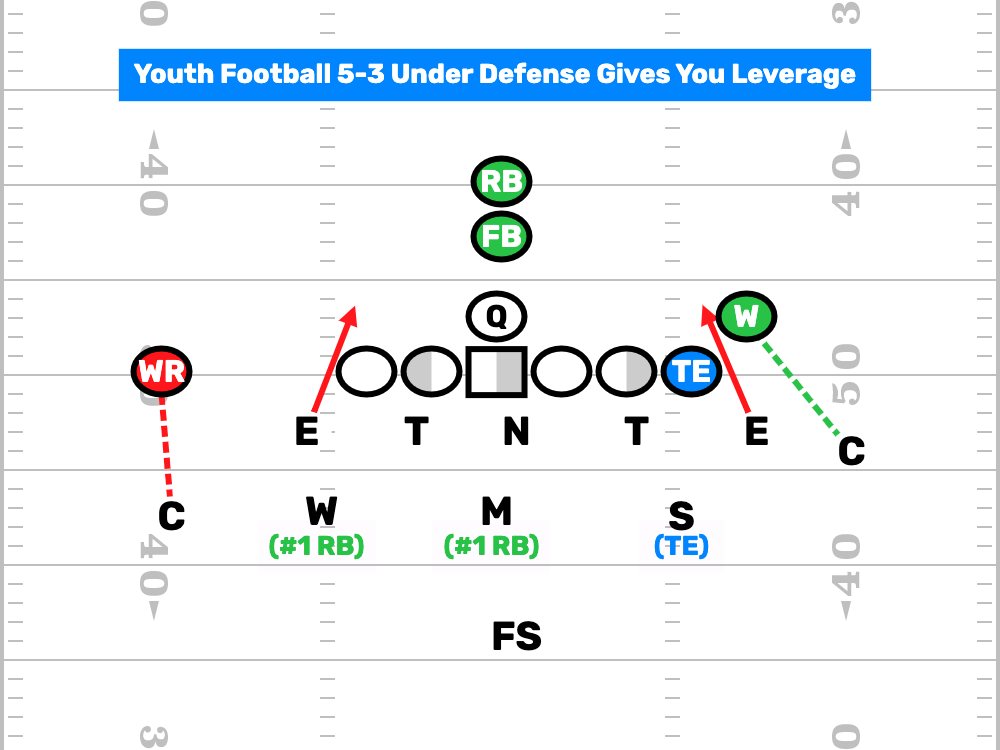
5. 5-3 Under Youth Football Defense
The FirstDown PlayBook 5-3 Under youth football defense is probably our least understood. The 5-3 part is not lost on anyone. It’s the way that you align your front five defenders that is a little different. This version of a 5-3 football defense for kids gives you great leverage in the run game where you need it.
When you coach youth football, you can get into a game where the offense is wearing you out to one side or the other. It might be inside or it might be outside. Sometimes, it can be both. An under front gives you a shaded nose, a 5 technique on the tackle, and a 9 technique on the tight end. You decide where you want that leverage by your strength call.
Just like the previous defenses we have mentioned, the 5-3 Under has been customized to fit a youth football team. You get the best of both worlds with this defensive front. You still have eight players dedicated to stopping the run and you get the leverage where you want it. Just a warning though, you need to understand your adjustments to formations inside and out to be good at this defense.
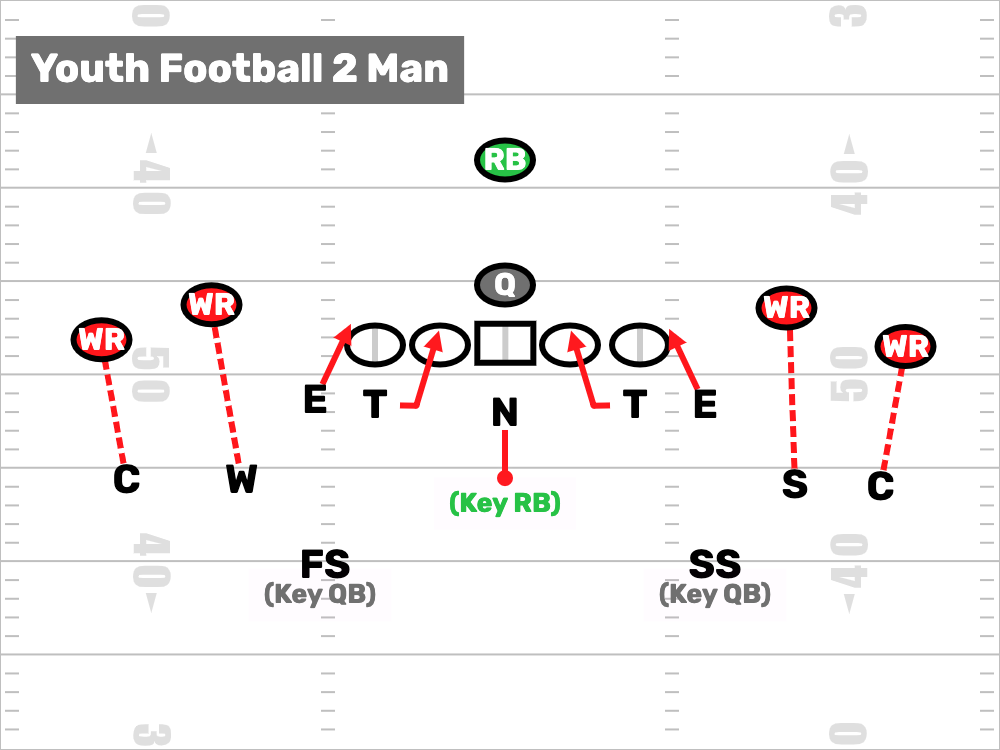
6. 5-2 Cover 2 Man Youth Football Defense
We have spent a considerable amount of focus on stopping the run game. Again, if you stop a youth football offense’s run game, you are going to have a lot of happy weekends. We do have to acknowledge that there are exceptions to almost anything. Meaning, that we are sure there are 11 or 12-year-old quarterbacks who can impact a football game throwing the football.
If and when this happens, then playing two deep safeties is one way to defend the passing game. Please keep in mind that playing two deep safeties or “cover 2” as it is called, is not easily taught. There are huge holes in this coverage if you do not understand it. It is much more than putting two players deep and playing five underneath.
This is why here at FirstDown PlayBook we recommend a version of cover 2 that gives you the best of both worlds. The 5-2 Cover 2 man is a sound defense because it still gives you plenty of run defense. Then you still have two deep safeties for extra pass defense. Your linebackers and defensive backs still play man coverage like they normally would. Now, your safeties key the quarterback and help where help is needed. You also have the luxury of dropping a safety down to play a 5-3 defense any time you want.
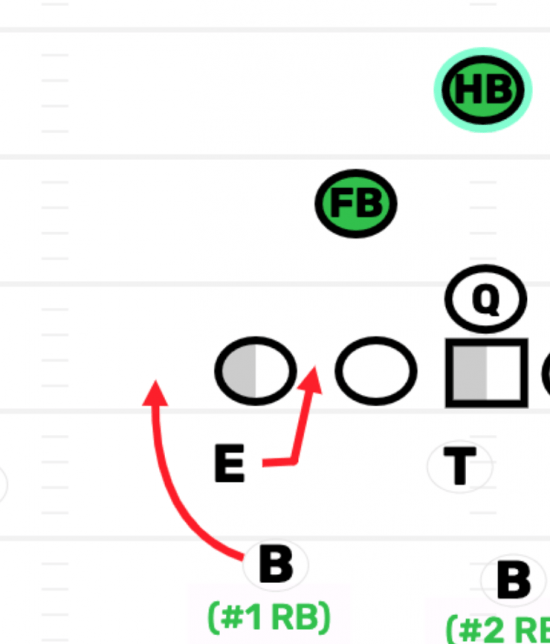
Defensive Line Stunts Can Help You
As you begin to learn more about the six sound football defenses for kids, you will likely find one that fits your team. After you begin to understand the base alignments, techniques, and adjustments, you may want to add a wrinkle or two to your defensive playbook. One of the best ways to do this is with a defensive line stunt.
Normally, a line stunt has one or two defensive linemen who are slanting (to the call) or angling (away from the call). A line stunt can be predetermined before the offense ever breaks the huddle. For instance, it could be a right or left call. It could also be made to stunt to the field or the boundary. Finally, if you have an experienced linebacker to make a Rip or Liz call at the line of scrimmage, the call could be made to a formation strength.
One simple and common defensive line stunt is the Pirate stunt. The Pirate stunt is really used at all levels of football. It is often used at the high school, college, and professional levels to protect an inside linebacker from run-pass conflict of assignment. At the youth football level, it is just a nice little change-up. The pirate stunt allows your defensive end to stunt inside while the linebacker protects the C gap.
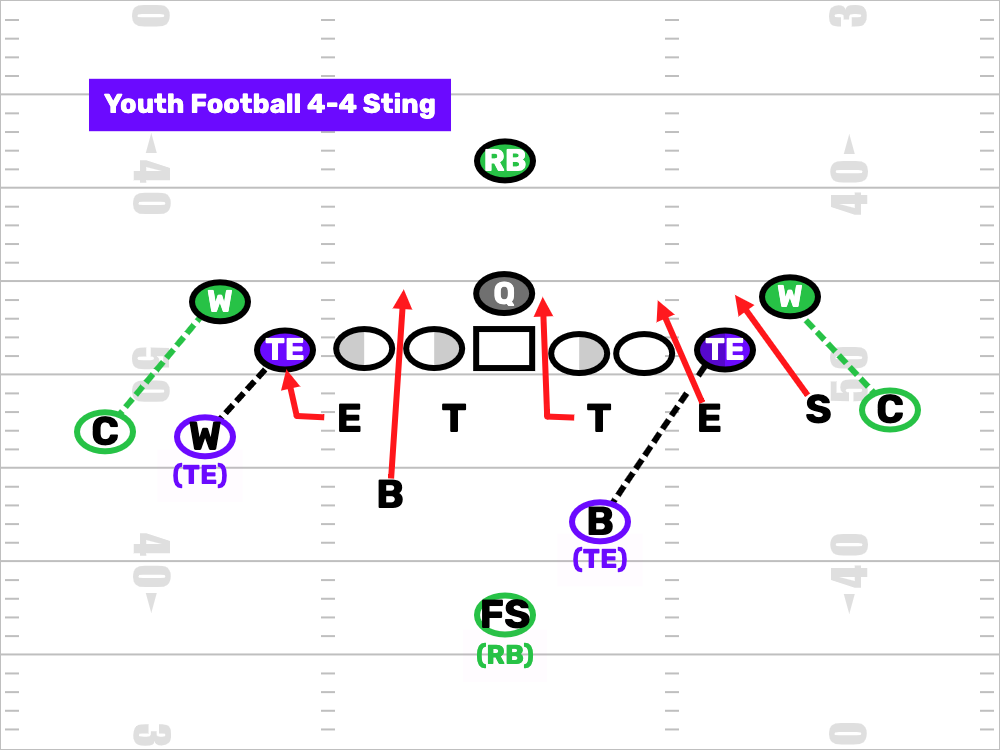
Youth Football Pressure? Yes, If You Know What You Are Doing?
Do we recommend defensive pressure for kids’ football defenses? Yes, if you understand all of your adjustments first. When you bring defensive pressure, you are still faced with the task of covering all of the eligible receivers. Be sure to address this first.
You will normally play either a man-free coverage or a pure zero coverage. Cover 0 has no free safety in the middle of the field. Man-free or cover one does have a middle safety. The easiest way to adjust to formations is to make sure your players count the eligibles from outside in.
If your players communicate and end up with five eligibles other than the quarterback, then you are in good shape. The pressure you dial-up should help with the amount of time the quarterback has to throw the ball. It will also help vs the run game as you should have every gap covered with your pressure. We recommend that you keep your pressures down to one or two max. Any more than that and you are likely going to have busted assignments. Busted assignments lead to big plays for the offense.
If your defensive unit is still at a point where getting lined up in your base defense is hard, our advice would be to stay basic. No defensive pressure is going to solve your problems if you can’t get lined up. So, master this part first before advancing to your youth football defensive pressures.

Lining Up vs Unbalanced Formations
Getting lined up to unbalanced and heavy formations can be difficult for defenses at any level. Mix in the fact that you are coaching a youth football defense and the job just got harder.
One of our FirstDown PlayBook youth coaches asked us how many defenses we would recommend running against an unbalanced offense. Our Answer? Not many. We suggested that he get a base defense that is solid to the overload side. After that, maybe include one pressure that he could use back to the short side.
Remember that your defense is going to have to recognize the formation every time they line up. Just because you see unbalanced one time, does not mean you will see it the next snap. From our standpoint, less is more. If you can line up to the opponent’s formations, you have a chance to be successful.
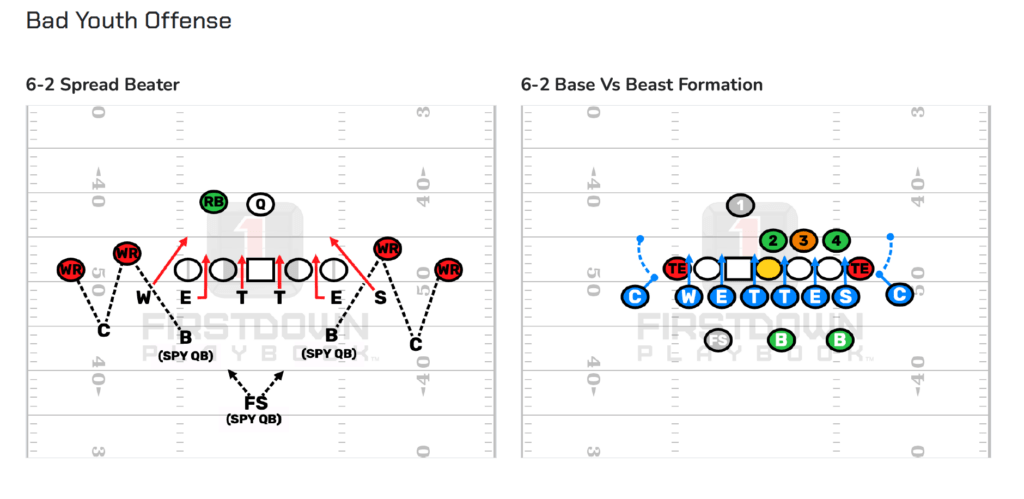
How To Defend Youth Football “Gimmick” Offenses
There are some offenses that we see out there in youth football that are obviously designed for the coach, not the players. FirstDown PlayBook is no fan of these gimmick offenses and we have been vocal about that. In our opinion, youth football offenses should be more about youth football drills and teaching the game, not making the coach happy.
This does not change the fact that you may have to defend one or more of these offenses. To sum up our philosophy on this, defend what they do, not what they pretend to do. Just because a youth football offense spreads the field does not make them a spread offense.
If a youth offense wants to line up in some rugby-type formation that is unrecognizable to a real football coach, then you will need to adjust. They are counting on you lining up in a good ole fashioned conventional defense. Don’t do it. Look at what they do and take that away first. Odds are the spread offense quarterback is still going to run the ball better than throw it. Remember that.
It is unfortunate that you have to reduce your fundamental football teaching when you play a coach like this, but here is the good news. After you take away the gimmick from the gimmick offense, they will return to a normal formation. When they do that, your base techniques will give your defense the advantage.
Above All…Remember Why You Are a Youth Football Coach
Youth coaches are the most valuable and the highest-paid football coaches in the world if you do it correctly. The first step towards doing it correctly is to do it for the right reasons. You must always remember why you are a youth football coach. Anyone who thinks it is to win football games, the exit door is over there.
If you want to win football games, go get a high school, college, or NFL job. This is where you coach football like your job depends on it, because oftentimes it does. Youth football is 100% about the kids that you are fortunate enough to coach. Football just happens to be the vessel that you get to use to teach your players positive character traits like work, dedication, responsibility, and many others.
If you do it right, there is a strong chance that your players will remember you and be influenced by you for a lifetime. They may very well grow up to become better humans than they otherwise would have. When you step back and look at the world today, it should be obvious that this alone makes you the most valuable and the highest-paid football coach alive. It is also a strong reminder about why you are a youth football coach.
